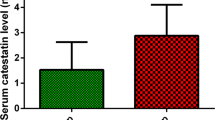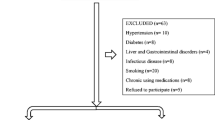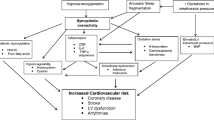Abstract
Objectives
Obstructive sleep apnea (OSA) is a sleep-disordered breathing leading to vascular endothelial cells dysfunction, cognitive impairment, and abnormal lipid metabolism. serum brain-derived neurotrophic factor (BDNF) protein, cortisol, and lipid levels in OSA were investigated.
Materials and methods
All middle-aged subjects including healthy individuals without signs and symptoms of apnea-hypopnea and ear nose throat (ENT) outpatients were randomly recruited and screened by overnight polysomnogram (PSG). Apnea-hypopnea index (AHI) was used as a criteria to determine subjects to enroll in this program. According to AHI, they were separated into control and OSA groups. A group of 39 OSA patients (AHI ≥ 10 events/h) and 24 control subjects (AHI < 5 events/h) were selected. Serum BDNF protein was analyzed by enzyme-linked immunosorbent assay (ELISA) from venous blood collection at 8:00 a.m. following PSG. Serum cortisol was assayed by enzyme-chemiluminescense immuno assay (ECLIA). Serum lipid profile levels were determined by enzymatic colorimetric and homogeneous method.
Results
Characteristics of OSA patients and control groups including gender, age, AHI, body weight, height, and BMI showed significant differences. Serum BDNF protein, cortisol, triglyceride, and total cholesterol levels in OSA and control groups were not significantly different. High density lipoprotein-cholesterol (HDL-c) in OSA was significantly lower than that of control (p = 0.008) while low density lipoprotein-cholesterol (LDL-c) was significantly higher than that of control (p = 0.04).
Conclusions
OSA had no significant effect on serum BDNF, cortisol, triglyceride, or total cholesterol levels while LDL-c and HDL-c levels in OSA patients compared to control were significantly different at p = 0.04, and p = 0.008, respectively.


Similar content being viewed by others
References
Young T, Palta M, Dempsey J, Skatrud J, Weber S, Badr S (1993) The occurrence of sleep-disordered breathing among middle-aged adults. N Engl J Med 328:1230–1235
Stoohs RA, Guilleminault C, Itoi A (1994) Traffic accidents in commercial long-haul truck drivers: the influence of sleep-disordered breathing and obesity. Sleep 17:619–623
Staats R, Stoll P, Zingler D, Virchow JC, Lommatzsch M (2005) Regulation of brain-derived neurotrophic factor (BDNF) during sleep apnoea treatment. Thorax 60:688–692
McNicholas WT, Tarlo S, Cole P, Zamel N, Rutherford R, Griffin D, Phillipson EA (1982) Obstructive apneas during sleep in patients with seasonal allergic rhinitis. Am Rev Respir Dis 126:625–628
Leznoff A, Haight JS, Hoffstein V (1986) Reversible obstructive sleep apnea caused by occupational exposure to guar gum dust. Am Rev Respir Dis 133:935–936
Zwillich CW, Pickett C, Hanson FN, Weil JV (1981) Disturbed sleep and prolonged apnea during nasal obstruction in normal men. Am Rev Respir Dis 124:158–160
Strüder HK, Hollmann W, Donike M, Platen P, Weber K (1996) Effect of O2 availability on neuroendocrine variables at rest and during exercise: O2 breathing increases plasma prolactin. Eur J Appl Physiol Occup Physiol 74:443–449
Somers VK (2005) Sleep: a new cardiovascular frontier. N Engl J Med 353:2070–2073
Ziegler MG, Mills PJ, Loredo JS, Ancoli-Israel S, Dimsdale JE (2001) Effect of continuous positive airway pressure and placebo treatment on sympathetic nervous activity in patients with obstructive sleep apnea. Chest 120:887–893
Ekstedt M, Akerstedt T, Söderström M (2004) Microarousals during sleep are associated with increased levels of lipids, cortisol, and blood pressure. Psychosom Med 66:925–931
Begliuomini S, Lenzi E, Ninni F, Casarosa E, Merlini S, Pluchino N, Valentino V, Luisi S, Luisi M, Genazzani AR (2008) Plasma brain-derived neurotrophic factor daily variations in men: correlation with cortisol circadian rhythm. J Endocrinol 197:429–435
Adlard PA, Cotman CW (2004) Voluntary exercise protects against stress-induced decreases in brain-derived neurotrophic factor protein expression. Neuroscience 124:985–992
Castrén E, Zafra F, Thoenen H, Lindholm D (1992) Light regulates expression of brain-derived neurotrophic factor mRNA in rat visual cortex. Proc Natl Acad Sci USA 89:9444–9448
Schaff MJM, Durland R, de Kloet ER, Vreugdenhjl E (1998) Downregulation of BDNF mRNA and protein in rat hippocampus by corticosterone. Brain Res 813:112–120
Katoh-Semba R, Wakako R, Komori T, Shigemi H, Miyazaki N, Ito H, Kumagai T, Tsuzuki M, Shigemi K, Yoshida F, Nakayama A (2007) Age-related changes in BDNF protein levels in human serum: differences between autism cases and normal controls. Int J Dev Neurosci 25:367–372
Widmaie PE, Raff H, Strang KT (2008) Vander’s human physiology. The mechanisms of body function, 11th edn. McGraw-Hill, New York, pp 319–321
Berne RM, Levy MN, Koeppen BM, Stanton BA (2004) Physiology, 5th edn. Mosby, Missouri, pp 890–901
Bratel T, Wennlund A, Carlström K (1999) Pituitary reactivity, androgens and catecholamines in obstructive sleep apnoea: effects of continuous positive airway pressure treatment (CPAP). Respir Med 93:1–7
Sapolsky RM (1992) Cortisol concentrations and the social significance of rank instability among wild baboons. Psychoneuroendocrinology 17:701–709
Fahnestock M, Garzon D, Holsinger RM, Michalski B (2002) Neurotrophic factors and Alzheimer's disease: are we focusing on the wrong molecule. J Neural Transm Suppl 62:241–252
Suwa M, Kishimoto H, Nofuji Y, Nakano H, Sasaki H, Radak Z, Kumagai S (2006) Serum brain-derived neurotrophic factor level is increased and associated with obesity in newly diagnosed female patients with type 2 diabetes mellitus. Metabolism 55:852–857
Tsuchida A, Nonomura T, Nakagawa T, Itakura Y, Ono-Kishino M, Yamanaka M, Sugaru E, Taiji M, Noguchi H (2002) Brain-derived neurotrophic factor ameliorates lipid metabolism in diabetic mice. Diabetes Obes Metab 4:262–269
Wang C, Godar R, Billington C, Kotz CM (2010) Chronic administration of brain-derived neurotrophic factor in the hypothalamic paraventricular nucleus reverses obesity induced by high fat diet. Am J Physiol Regul Integr Comp Physiol 298:R1320–R1332
Jianguo L, Grigoryev DN, Ye SQ, Thorne L, Schwartz AR, Smith PL, O'Donnell CP, Polotsky VY (2005) Chronic intermittent hypoxia upregulates genes of lipid biosynthesis in obese mice. J Apply Physiol 99:1643–1648
McEwen BS (2008) Central effects of stress hormones in health and disease: Understanding the protective and damaging effects of stress and stress mediators. Eur J Pharmacol 583:174–185
Gangwisch JE (2009) Epidemiological evidence for the links between sleep, circadian rhythms and metabolism. Obes Rev 10:37–45
Bassiri A, Guilliminault C (2000) Clinical feature and evaluation of obstructive sleep apnea hypopnea syndrome. In: Kryger M (ed) Principle and practice of sleep medicine, 3rd edn. Saunders, Philadelphia, pp 869–878
American Academy of Sleep Medicine Task Force (1999) Sleep related breathing disorders in adults: recommendations for syndrome definition and measurement techniques in clinical research. Report of an American Academy of Sleep Medicine Task Force. Sleep 22:667–689
Naito HK, David JA (1984) Laboratory considerations: determination of cholesterol, triglyceride, phospholipid, and other lipids in blood and tissues. Lab Res Methods Biol Med 10:1–76
Deeg R, Ziegenhorn J (1983) Kinetic enzymatic method for automated determination of total cholesterol in serum. Clin Chem 10:1798–1802
Nauck M, März W, Wieland H (1998) New immunoseparation-based homogeneous assay for HDL-cholesterol compared with three homogeneous and two heterogeneous methods for HDL-cholesterol. Clin Chem 44:1443–1451
Lang UE, Hellweg R, Gallinat J (2004) BDNF serum concentration in healthy volunteers are associated with depression-related personality traits. Neuropharma 29:795–798
Aardal E, Holm AC (1995) Cortisol in saliva–reference ranges and relation to cortisol in serum. Eur J Clin Chem Clin Biochem 12:927–932
Wahner-Roedler DL, Olson EJ, Narayanan S, Sood R, Hanson AC, Loehrer LL, Sood A (2007) Gender-specific differences in a patient population with obstructive sleep apnea-hypopnea syndrome. Gend Med 4:329–338
Janssens JP, Pautex S, Hilleret H, Michel JP (2000) Sleep disordered breathing in the elderly. Aging 12:417–429
Knorst MM, Souza FJ, Martinez D (2008) Obstructive sleep apnea-hypopnea syndrome: association with gender, obesity and sleepiness-related factors. J Bras Pneumol 34:490–496
Bradley TD, Phillipson EA (1985) Pathogenesis and pathophysiology of the obstructive sleep apnea syndrome. Med Clin North Am 69:1169–1185
Millman RP (1987) Snoring and apnea. Clin Chest Med 8:253–264
Levinson PD, Millman RP (1991) Causes and consequences of blood pressure alterations in obstructive sleep apnea. Arch Intern Med 151:455–462
Börgel J, Sanner BM, Bittlinsky A, Keskin F, Bartels NK, Buechner N, Huesing A, Rump LC, Mügge A (2006) Obstructive sleep apnoea and its therapy influence high-density lipoprotein cholesterol serum levels. Eur Respir J 27:121–127
Schuld A, Hebebrand J, Geller F, Pollmächer T (2000) Increased body-mass index in patients with narcolepsy. Lancet 355:1274–1275
Wessendorf TE, Alymov G, Wang YM, Stampa J, Thilmann AF, Teschler H (2002) Pulse oximetry screening for sleep-disordered breathing in stroke. Pneumologie 56:357–362 (in German)
Oeverland B, Skatvedt O, Kvaerner KJ, Akre H (2002) Pulseoximetry: sufficient to diagnose severe sleep apnea. Sleep Med 3:133–138
Böhning N, Schultheiss B, Eilers S, Penzel T, Böhning W, Schmittendorf E (2010) Comparability of pulse oximeters used in sleep medicine for the screening of OSA. Physiol Meas 31:875–888
Hurewitz AN, Sampson MG (1987) Voluntary breath holding in the obese. J Appl Physiol 62:2371–2376
Farmery AD, Roe PG (1996) A model to describe the rate of oxyhaemoglobin desaturation during apnoea. Br J Anaesth 76:284–291
Peppard PE, Ward NR, Morrell MJ (2009) The impact of obesity on oxygen desaturation during sleep-disordered breathing. Am J Respir Crit Care Med 180:788–793
Fanfulla F, Grassi M, Taurino AE, D'Artavilla Lupo N, Trentin R (2008) The relationship of daytime hypoxemia and nocturnal hypoxia in obstructive sleep apnea syndrome. Sleep 31:249–255
Banerjee D, Yee BJ, Piper AJ, Zwillich CW, Grunstein RR (2007) Obesity hypoventilation syndrome: hypoxemia during continuous positive airway pressure. Chest 131:1678–1684
Olson AL, Zwillich C (2005) The obesity hypoventilation syndrome. Am J Med 118:948–956
Phipps PR, Starritt E, Caterson I, Grunstein RR (2002) Association of serum leptin with hypoventilation in human obesity. Thorax 57:75–76
Lommatzsch M, Zingler D, Schuhbaeck K, Schloetcke K, Zingler C, Schuff-Werner P, Virchow JC (2005) The impact of age, weight and gender on BDNF levels in human platelets and plasma. Neurobiol Aging 26:115–123
Hubold C, Lang UE, Gehring H, Schultes B, Schweiger U, Peters A, Hellweg R, Oltmanns KM (2009) increased serum brain-derived neurotrophic factor protein upon hypoxia in healthy young men. Neural Transm 116:1221–1225
Mitchell JJ, Paiva M, Walker DW, Heaton MB (1999) BDNF and NGF afford in vitro neuroprotection against ethanol combined with acute ischemia and chronic hypoglycemia. Dev Neurosci 21:68–75
Golden E, Emiliano A, Maudsley S, Windham BG, Carlson OD, Egan JM, Driscoll I, Luigi F, Martin B, Mattson MP (2010) Circulating Brain-Derived Neurotrophic Factor and Indices of Metabolic and Cardiovascular Health: Data from the Baltimore Longitudinal Study of Aging. PLoS ONE 5(4):e10099. doi:10, 1371/journal.pone.0010099
Semenkovich CF, Ostlund RE Jr, Levy RA, Steven RO (1982) Low Density Lipoprotein Receptor Activity in Homozygous Familial Hypercholesterolemia Fibroblasts. J Biol Chem 257:12857–12865
Carneiro G, Togeiro SM, Hayashi LF, Ribeiro-Filho FF, Ribeiro AB, Tufik S, Zanella MT (2008) Effect of continuous positive airway pressure therapy on hypothalamic-pituitary-adrenal axis function and 24-h blood pressure profile in obese men with obstructive sleep apnea syndrome. Am J Physiol Endocrinol Metab 295:E380–E384
Parlapiano C, Borgia MC, Minni A, Alessandri N, Basal I, Saponara M (2005) Cortisol circadian rhythm and 24-hour Holter arterial pressure in OSAS patients. Endocr Res 31:371–374
Buckley TM, Schatzberg AF (2005) On the interactions of the hypothalamic-pituitary-adrenal (HPA) axis and sleep: normal HPA axis activity and circadian rhythm, exemplary sleep disorders. J Clin Endocrinol Metab 90:3106–3114
Kim HG, Lim EY, Jung WR, Shin MK, Ann ES, Kim KL (2008) Effects of treadmill exercise on hypoactivity of the hypothalamo-pituitary-adrenal axis induced by chronic administration of corticosterone in rats. Neurosci Lett 434:46–49
Jianguo L, Vladimir S, Ashika N, Smith PL, O'Donnell CP, Polotsky VY (2007) Hyperlipidemia and lipid peroxidation are dependent on the severity of chronic intermittent hypoxia. J Appl Physiol 102:557–563
Vgontzas AN, Bixler EO, Chrousos GP (2003) Metabolic disturbances in obesity versus sleep apnoea: the importance of visceral obesity and insulin resistance. J Intern Med 254:32–44
Vgontzas AN, Bixler EO, Chrousos GP (2005) Sleep apnea is a manifestation of the metabolic syndrome. Sleep Med Rev 9:211–224
Tan KC, Chow WS, Lam JC, Lam B, Wong WK, Tam S, Ip MS (2006) HDL dysfunction in obstructive sleep apnea. Atherosclerosis 184:377–382
Kloepfer C, Riemann D, Nofzinger EA, Feige B, Unterrainer J, O'Hara R, Sorichter S, Nissen C (2009) Memory before and after sleep in patients with moderate obstructive sleep apnea. J Clin Sleep Med 15:540–548
Erickson KI, Prakash RS, Voss MW, Chaddock L, Heo S, McLaren M, Pence BD, Martin SA, Vieira VJ, Woods JA, McAuley E, Kramer AF (2010) Brain-derived neurotrophic factor is associated with age-related decline in hippocampal volume. J Neurosci 30:5368–5375
Al-Shawwa BA, Badi AN, Goldberg AN, Woodson BT (2008) Defining common outcome metrics used in obstructive sleep apnea. Sleep Med Rev 12:449–461
Acknowledgements
This study was funded by HRH Princess Mahachakri Sirindhorn Medical Center, Ongkarak campus, Faculty of Medicine, Srinakharinwirot University, Nakornnayok. Thailand. We would like to thank Asst. Prof. Wichit Leelasithorn, a specialized radiologist doctor, for providing control subjects’ polysomnogram data, Dr. Villarroel A. and Asst. Prof. Dr. Orapin Wongsawatkul for editing the manuscript.
Conflict of interest
This study has no conflict of interest between collaborators. We have no financial relationship with the organization that sponsored this research.
Author information
Authors and Affiliations
Corresponding author
Rights and permissions
About this article
Cite this article
Panaree, B., Chantana, M., Wasana, S. et al. Effects of obstructive sleep apnea on serum brain-derived neurotrophic factor protein, cortisol, and lipid levels. Sleep Breath 15, 649–656 (2011). https://doi.org/10.1007/s11325-010-0415-7
Received:
Revised:
Accepted:
Published:
Issue Date:
DOI: https://doi.org/10.1007/s11325-010-0415-7




